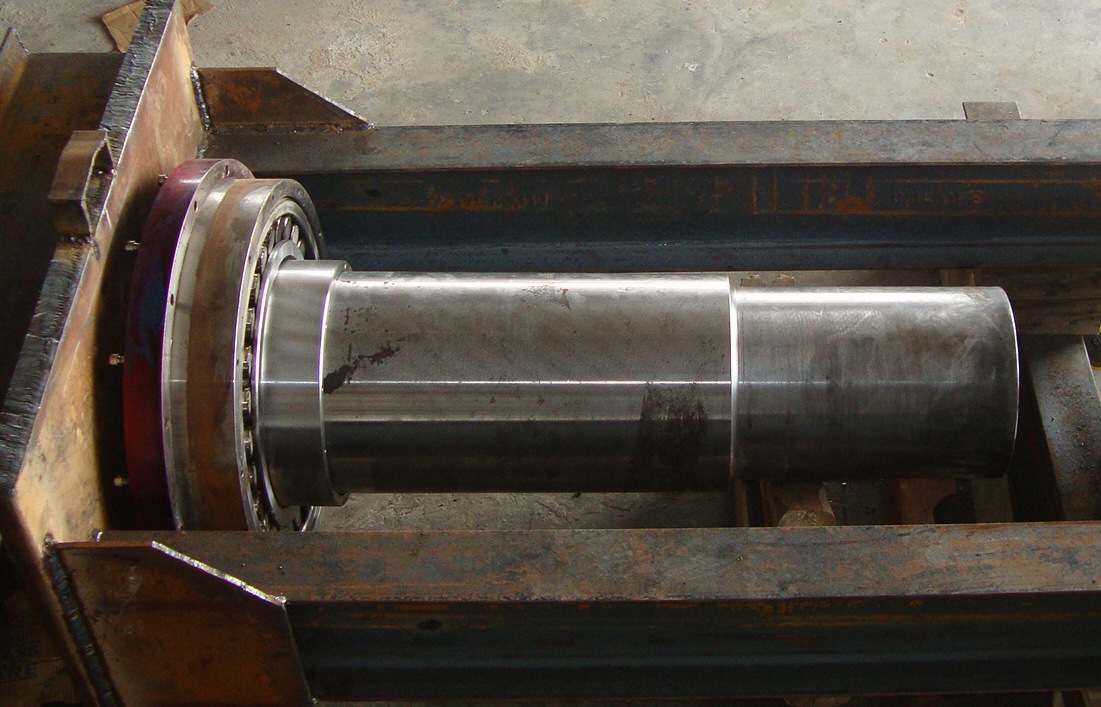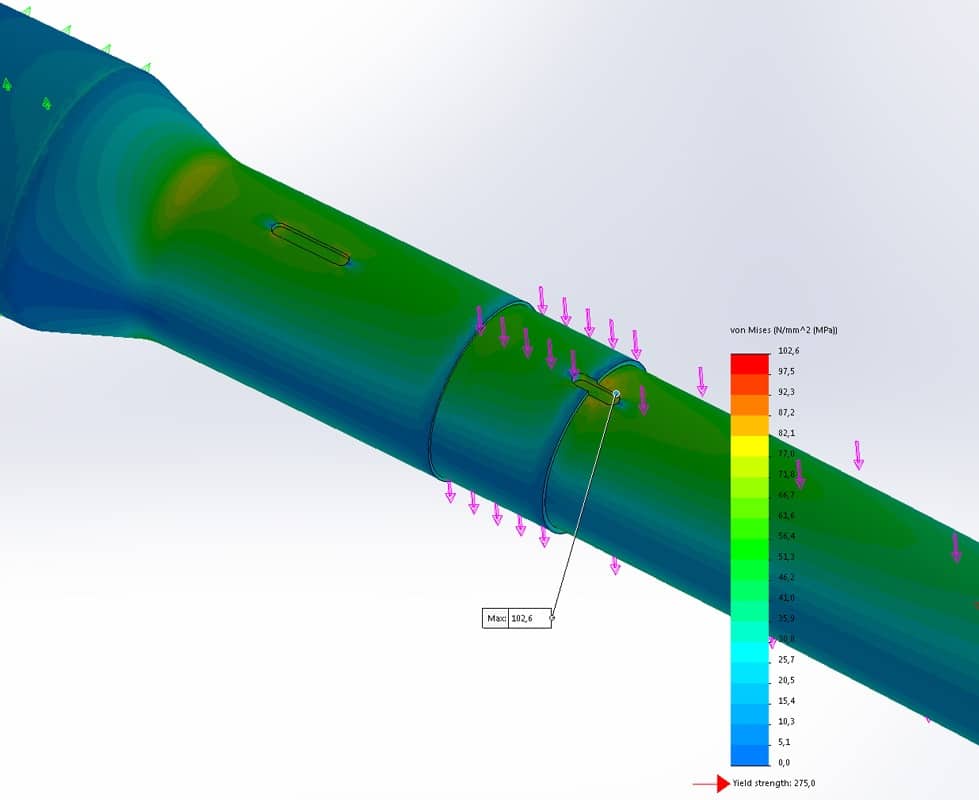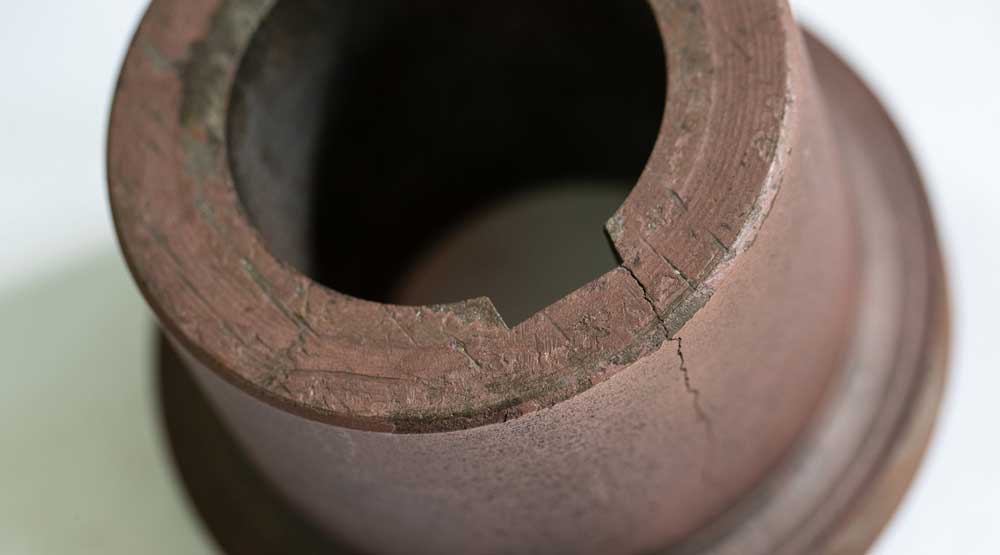Failure by fatigue – an elevated risk on standard CFW machines that can be avoided!
“Don’t worry. Our CFW machine is very strong. It will produce this diameter without any problem,” the plant manager said to me about their Continuous Winder during the production of an ND 700 ST 10000 PN10, utilizing a smaller mandrel shaft.
I had reasons to believe that he might have been wrong.
Consequently, I strongly suggested an inspection of the shaft, but he insisted on his chain of thought: “Don’t worry, we have already produced the blank for the sleeve without any problem, and we only have a few kilometers to go to finish the job. You know, the delivery dates are very tight, and we will face penalties in case of delays.”
Before I continue with the story and reveal some hidden dangers in the standard Continuous Filament Winding plant, let me explain fatigue.
Fatigue
Fatigue can be explained as the weakening of material due to fluctuating loads that result in damage to the material’s structure and eventual failure. As children, we learned that metal could break by bending it back and forth several times, with a certain amplitude. Each back-and-forth bending is one cycle. When the wire finally breaks, you can count the number of cycles it took to lead to the initial crack and final break.
The break can happen quite easily, even at small loads, and a small number of load cycles, depending on the material.
The damage inflicted during the fatigue process is cumulative and generally unrecoverable, due to the following reasons:
- It is nearly impossible to detect any progressive changes in material behavior during the fatigue process, so failures often occur without warning;
- Periods of rest, with the fatigue stress removed, do not lead to any measurable healing or recovery.
When working with Continuous Filament Winding® Lines, we need to be aware that its parts and components are subjected to fluctuating or cyclic loads that may lead to failure due to fatigue. Some components of a machine are more likely to succumb to breaking due to fluctuating stresses. For example, one of these is the mandrel shaft. We imagine the shaft as a straight, strong component that is rotating during production.

But in reality, the shaft is slightly bent during production, and its rotation causes multiple bending.
Fatigue failure happens without warning
The second day of my audit was dedicated to the lab procedures to improve the process. Suddenly an impressive sound came through from the production area. The production had stopped. Fortunately, nobody was injured, but the mandrel shaft had broken.
Keep in mind one important fact. Fatigue failure happens without warning.
Under careful observation, some indications were evident. The shaft’s design was incorrect, and the manufacturing process had been carried out incorrectly. All this led to defects that appeared after a certain number of cycles and stress on the shaft.
Had we been able to inspect the parts before production continued, we could have changed the set-up and increased the shaft’s lifetime. The plant manager finally understood why I had asked to check the shaft the day before.
In the end, the production losses due to the shutdown and penalties amounted to several hundred thousand euros, and the commercial impact in the market was not so easy to recover.
The plant manager was wrong about his CFW machine, but one question remains unanswered for me.
How many companies prefer to take a big risk during production instead of proceeding with a Plant Audit?
I will soon tell you the answer, but let me explain what the Fatigue analysis philosophies are.
Fatigue design philosophy
There are three main fatigue design philosophies. Each one centers around one of the fatigue life estimation methodologies:
- Safe Life;
- Fail-Safe;
- Damage Tolerant.
Safe Life
The Safe Life philosophy is a philosophy adopted by many. In a few words, products are designed to survive a specific design life.
Fail-Safe
On the other end of the spectrum of design philosophies is that of Fail-Safe. This is where a failure must be avoided at all costs. And if the structure were to fail, it must fall into a state such that it would survive until repairs can be made.
Damage Tolerant
The middle ground philosophy is that of Damage Tolerant. This philosophy, adopted heavily in the aerospace community and in nuclear power generation, relies on the assumption that a flaw already exists and that a periodic inspection schedule will be set up to ensure that a crack, for example, does not propagate to a critical state in between inspection periods. As implied, this philosophy adopts the crack growth method.
As you can see, it is not only if the parts are subjected to a fatigue analysis but also the design philosophy used for the analysis.
Dedicated software for fatigue analysis
During the design of our Effective Filament Winding® Lines, all the critical components are subjected to a complete fatigue analysis, using dedicated software.
Why “dedicated software”?
The fatigue analyses on our EFW® equipment are quite specific. The method philosophy is adopted and is one of the keys to the successful design and efficient operation of the filament winding plant.
Be careful. In the market, you will also find 3D model software that performs a simple fatigue analysis that is not appropriate for this type of application, but the reports look very similar.

Coming back to the Plant Audit for your Plant, why not prevent a potential disaster?
By running fatigue analyses on your CFW machine, you will visualize your equipment’s current status and have the instruments to decide on the way forward. This way you avoid unnecessary investments but at the same time make the right decisions to prevent accidents of this nature.
We dedicate a significant amount of our time daily to designing and improving the equipment’s critical components to finding the best and simplest solution for running Plants that were manufactured years ago and that now are under high stress due to the new market demands.
I personally believe that when you try the benefits of our Audit for the first time, you will agree: “It is well worth the price.”

